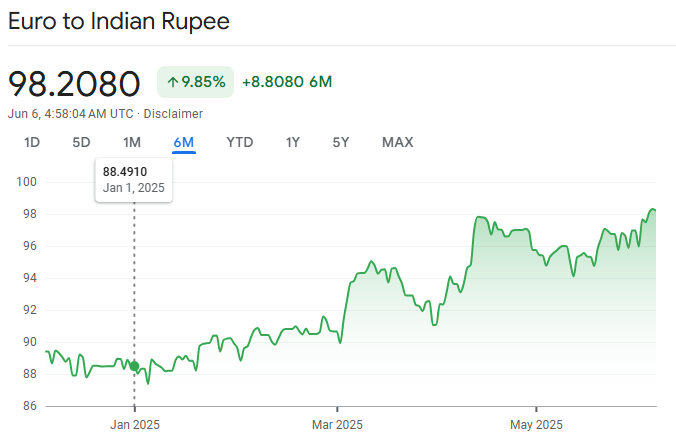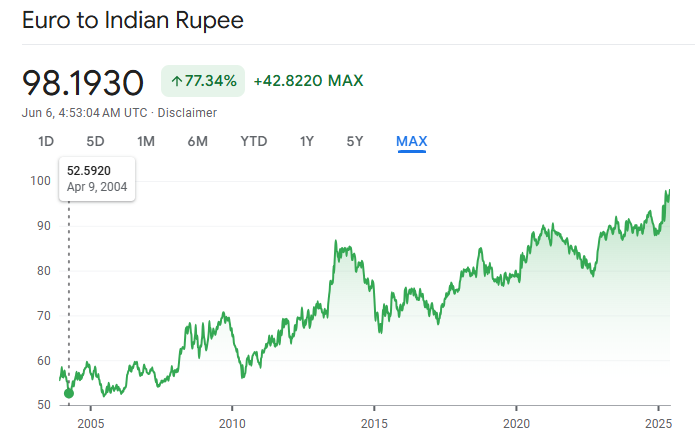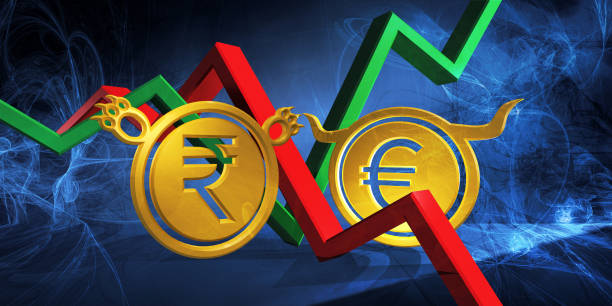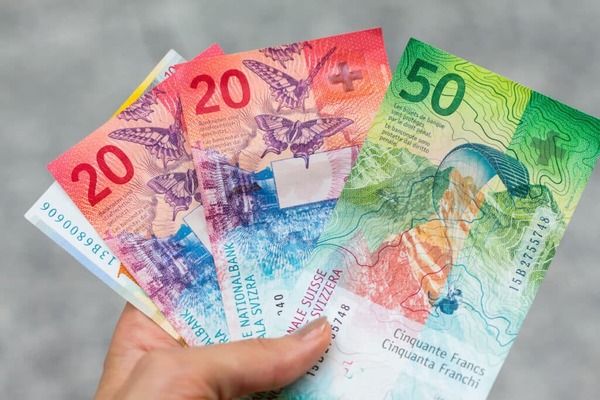The Euro to Indian Rupee (EUR/INR) exchange rate is a critical metric for investors and traders. As we progress through 2025, understanding the dynamics influencing this currency pair is essential.
This article explains expert forecasts, economic factors, and market sentiments to assess whether the Euro is poised to strengthen against the Indian Rupee by the end of 2025.
Current EUR to INR Exchange Rate

As of June 6, 2025, the EUR/INR exchange rate stands at approximately ₹98.23. This rate reflects a significant appreciation from the beginning of the year, when the Euro was valued at around ₹88.09 on January 2, 2025.
Technical Analysis
Technical indicators provide insights into market trends:
Relative Strength Index (RSI): An RSI above 70 suggests an overbought market, while below 30 indicates oversold conditions.
Moving Averages: The EUR/INR rate is currently above both the 50-day and 200-day simple moving averages, indicating a bullish trend.
Factors Influencing the EUR/INR Exchange Rate
1. Economic Indicators
Eurozone
GDP Growth: The Eurozone's economic performance, including GDP growth rates, significantly impacts the Euro's strength.
Inflation Rates: Higher inflation can erode purchasing power, affecting the currency's value.
Interest Rates: Decisions by the European Central Bank (ECB) on interest rates influence investor confidence and currency strength.
India
Economic Growth: India's GDP growth can attract foreign investment, strengthening the Rupee.
Inflation Control: Effective inflation management by the Reserve Bank of India (RBI) supports Rupee stability.
Fiscal Policies: Government spending and taxation policies can impact health and currency value.
2. Trade Balances
A trade surplus in the Eurozone can bolster the Euro, while a trade deficit in India may weaken the Rupee.
3. Political Stability
Political events, elections, and policy changes in either region can cause currency volatility.
Historical Performance of EUR to INR

1. Early 2000s: Introduction and Stability
2002: The Euro was officially introduced as a physical currency in the Eurozone in 2002. Around this time, the EUR/INR rate was roughly ₹42 to ₹46.
The Indian Rupee remained relatively stable against the Euro due to India's robust growth, fiscal discipline, and the early-stage development of India's foreign exchange markets.
2. 2008 Financial Crisis: INR Depreciation Begins
2008: The global financial crisis led to risk aversion among investors, resulting in capital outflows from emerging markets such as India.
The EUR/INR rate surged to ₹70, marking a significant depreciation of the Rupee.
Investors sought safer European assets despite economic concerns in Europe itself, boosting the Euro's value temporarily.
3. 2010–2013: Eurozone Debt Crisis
During the European sovereign debt crisis, the Euro weakened globally, but the Rupee depreciated even more sharply due to India's high current account deficit and inflation.
EUR/INR fluctuated widely, peaking above ₹78 in 2013.
The Euro's perceived instability did not prevent it from appreciating against the Rupee amidst India's domestic macroeconomic challenges.
4. 2014–2016: Modi Era Reforms and INR Stabilisation
The election of Narendra Modi in 2014 led to greater investor optimism in Indian markets.
India's foreign direct investment (FDI) flows improved, and inflation began to fall, helping stabilise the Rupee.
EUR/INR traded in the ₹68 to ₹74 range during this period, reflecting reduced volatility.
5. 2017–2019: Relative Stability with Euro Volatility
The Euro remained under pressure due to Brexit negotiations and sluggish Eurozone growth.
Meanwhile, India maintained a stable inflation outlook and increased foreign exchange reserves.
EUR/INR moved within a narrow range of ₹76–₹82.
6. 2020–2021: COVID-19 Pandemic Impact
The pandemic caused extreme volatility across currency markets.
In early 2020, the Euro initially weakened but later gained strength as the European Central Bank (ECB) deployed stimulus measures.
The Rupee weakened due to lockdown-induced economic contraction.
EUR/INR touched a high of ₹89.84 in August 2020.
7. 2022–2023: ECB Tightening vs Global Inflation
The ECB raised interest rates to combat inflation, increasing the value of the Euro.
However, the INR was pressured by high oil prices and global economic uncertainty.
The EUR/INR pair oscillated between ₹80 to ₹90, with the Euro recovering after a brief dip in early 2022.
8. 2024: Pre-Election Effects and Market Realignment
India's general election cycle and expectations of further reforms contributed to foreign inflows.
However, the Euro gained strength on the back of solid GDP performance in Germany and France, along with rate hikes by the ECB.
EUR/INR reached ₹91.15 by December 2024.
9. 2025 So Far: Strong Euro Momentum
As of January to May 2025, the EUR/INR has continued its upward trend:
January: ₹88.09
February: ₹89.45
March: ₹91.32
April: ₹95.66
May: ₹98.23
Factors include continued Eurozone resilience, India's widening trade deficit, and capital outflows from Indian equity markets in the second quarter of 2025.
Euro to INR Forecast and Long-Term Outlook

| Month |
Forecasted Rate (₹) |
Potential ROI (%) |
| June 2025 |
100.22 |
3.42 |
| July 2025 |
105.20 |
9.53 |
| August 2025 |
105.30 |
8.43 |
| September 2025 |
107.19 |
10.93 |
| October 2025 |
109.99 |
14.33 |
| November 2025 |
109.95 |
13.18 |
| December 2025 |
111.67 |
14.64 |
Long-Term Outlook
Looking beyond 2025, experts forecast the EUR/INR rate to reach ₹123.27 by mid-2026 and ₹138.30 by 2030, indicating a long-term bullish trend for the Euro.
Conclusion
In conclusion, the Euro is projected to strengthen against the Indian Rupee throughout 2025, driven by favourable economic indicators in the Eurozone and technical market trends.
While forecasts vary, the consensus leans towards a bullish outlook for the Euro, with potential exchange rates ranging from ₹97.35 to ₹112.60 by year-end.
Disclaimer: This material is for general information purposes only and is not intended as (and should not be considered to be) financial, investment or other advice on which reliance should be placed. No opinion given in the material constitutes a recommendation by EBC or the author that any particular investment, security, transaction or investment strategy is suitable for any specific person.









